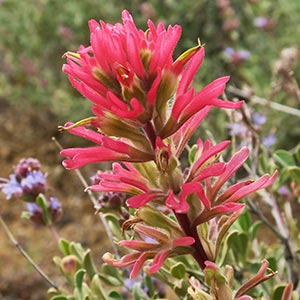Castilleja angustifolia
Castilleja coccinea
narrow-leaf paintbrush, northwestern Indian paintbrush, northwestern paintbrush, violet desert paintbrush
painted-cup, red paintbrush, scarlet Indian paintbrush, scarlet paintbrush, scarlet painted-cup
few to many, ascending to erect, branched, especially near base, sometimes unbranched, hairs sparse to dense, spreading to retrorse, long, sometimes short, soft to stiff, usually mixed with short-glandular ones, sometimes viscid.
solitary or few, erect to ascending, unbranched, rarely branched, hairs spreading, long, soft, eglandular, others shorter and glandular.
brown or purplish, sometimes green, linear to lanceolate or broadly lanceolate, 1.2–7(–7.5) cm, not fleshy, margins plane, sometimes ± wavy, involute or flat, (0–)3–5-lobed, rarely with secondary lobes, apex acuminate to rounded;
lobes spreading, oblong or lanceolate to linear-lanceolate, apex acute to rounded.
green to sometimes brownish, rosette leaves persisting or withered at anthesis, oblanceolate to oblong-lanceolate, 1–3 cm, usually 0-lobed;
cauline leaves linear-lanceolate to oblong-lanceolate, 2–7(–8) cm, not fleshy, margins plane, sometimes wavy, involute, 3–7(–9)-lobed, apex acute to acuminate;
cauline leaves: lobes spreading to ascending, linear to oblong, (2–)5–25 mm, apex acuminate.
2.5–20 × 1.5–5 cm;
bracts proximally greenish or dull purplish, distally pink, magenta, pink-purple, reddish pink, pale yellow, pale yellow-orange, pale orange, or white, rarely reddish or orange-red, lanceolate to oblong, 3–5(–9)-lobed, sometimes with secondary lobes;
lobes spreading or ascending, oblanceolate or linear, proximal lobes often much longer than distal, proximal lobes arising below or a little above mid length, apex acute to rounded.
2–35 (longest in fruit) × 1.5–6 cm;
bracts proximally greenish to brownish green, distally red, sometimes orange, yellow, or white, lanceolate to obovate, 3(–5)-lobed;
lobes spreading-ascending, lanceolate and longer on proximal bracts, becoming oblanceolate, shorter, and wider on distal bracts, arising from distal 3/4 of blade, apex acute to rounded.
straight, 18–27(–32) mm;
tube 8–17 mm;
beak usually long-exserted, adaxially green or pink, 8–15 mm;
abaxial lip deep green, reduced, inconspicuous, 1–2.5 mm, 5–20% as long as beak;
teeth incurved to ascending, deep green, 0.5–1.5 mm.
straight, 18–31 mm;
tube 15–18 mm;
abaxial lip ± exserted, beak exserted, often whitish, yellowish, or faint dull reddish proximally, adaxially green distally, 7–10 mm;
abaxial lip green to yellowish, apex pink to yellow, reduced, ± protuberant, 1.5–4 mm, 20–33% as long as beak;
teeth erect, green or yellow, apices white, yellow, or pink, 2–4(–5) mm.
proximally green, yellow, brown, or purple, lobes colored as bract lobes, sometimes with a yellow band between proximal and distal parts, 13–25(–28) mm;
abaxial clefts 3–8 mm, adaxial 5–9(–12) mm, clefts 30–50% of calyx length, deeper than laterals, lateral (1–)1.5–4(–5) mm, 10–25% of calyx length;
lobes lanceolate to oblong, abaxials wider than adaxials, apex acute to rounded.
colored as bracts, 17–23(–28) mm;
abaxial clefts 6–10 mm, adaxial 5–8 mm, clefts 33–50% of calyx length, deeper than laterals, lateral 0–1 mm, 0–5% of calyx length;
lobes oblong to triangular, apex rounded to truncate, sometimes emarginate.
= 24, 46, 48.
Castilleja angustifolia
Castilleja coccinea
Varieties 3 (3 in the flora).
Much confusion exists concerning Castilleja angustifolia and the closely related C. chromosa. Sometimes C. chromosa is treated as a variety of C. angustifolia, using the name C. angustifolia var. dubia. The latter name is used here to represent a different assemblage of plants, not including C. chromosa. At other times, C. chromosa is synonymized completely under C. angustifolia. However, the two species are in most cases easily separable, and where they are sympatric there is little evidence of intergradation. Both C. angustifolia var. dubia and C. chromosa are accepted here. See additional comments under 3b. C. angustifolia var. dubia and 15. C. chromosa.
(Discussion copyrighted by Flora of North America; reprinted with permission.)
Castilleja coccinea usually has red bracts. Forms with white or yellow bracts have been named but are scattered across the range of the species. However, yellow-bracted forms become markedly more common in populations in the northern portion of the range, especially in the upper midwestern region. Populations of C. coccinea seem ephemeral, disappearing from one site after a few years and appearing in another. It is rare in much of the eastern portion of its range, and apparently is extirpated in Louisiana, Maine, Massachusetts, and New Hampshire.
(Discussion copyrighted by Flora of North America; reprinted with permission.)
1. Bracts distally usually pink to pink-purple; s Idaho, sw Montana, se Oregon, nw Wyoming. | var. angustifolia |
1. Bracts distally yellow, yellow-orange, pale orange, white, pink, reddish pink, or magenta; se Idaho, e Nevada, sw South Dakota, w Utah, ec Wyoming. | → 2 |
2. Bracts distally usually yellow to pale orange or white; ec Wyoming, adjacent sw South Dakota. | var. dubia |
2. Bracts distally usually yellow, yellow-orange, white, pink, or reddish pink; se Idaho, e Nevada, w Utah. | var. flavescens |


